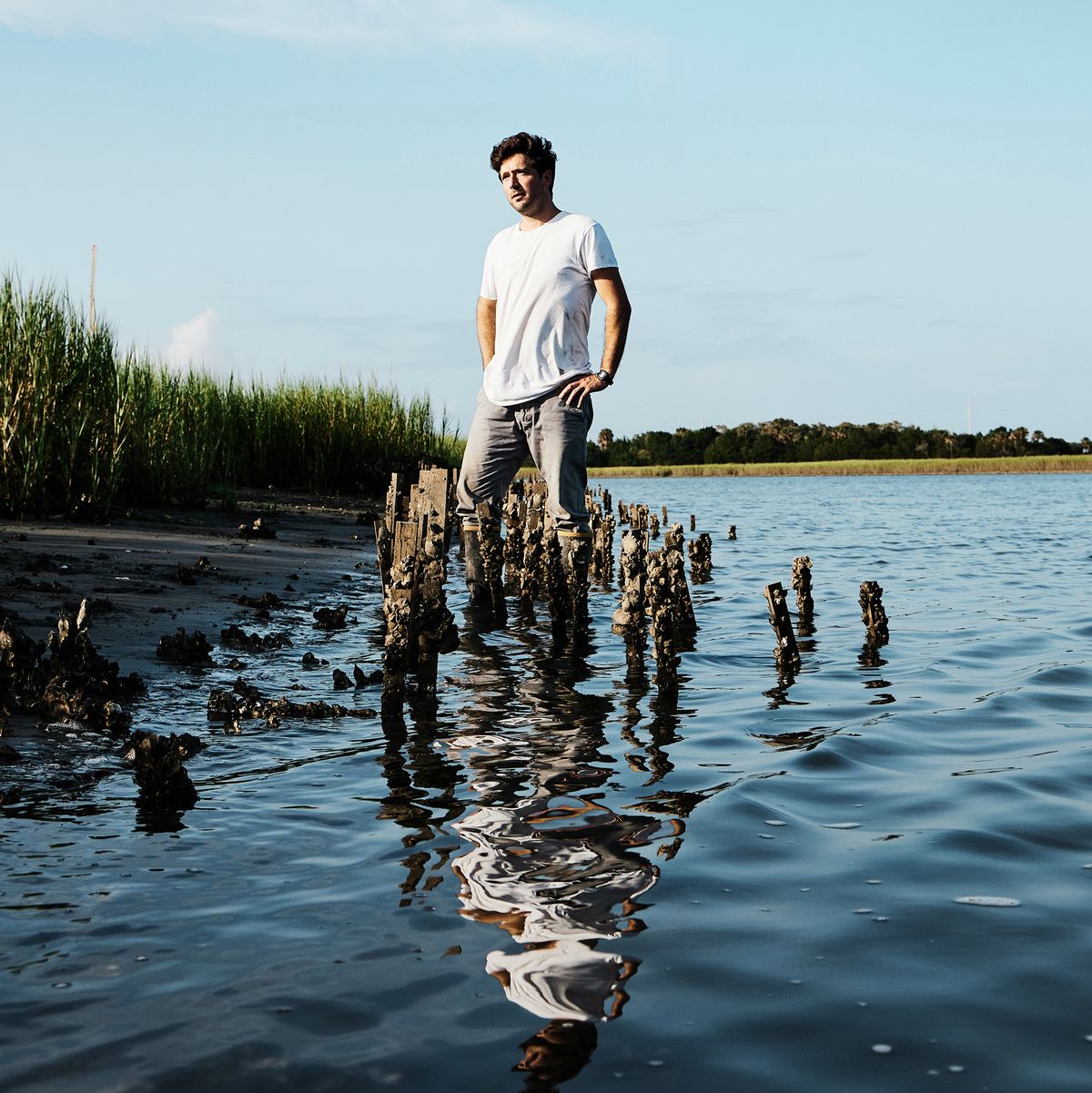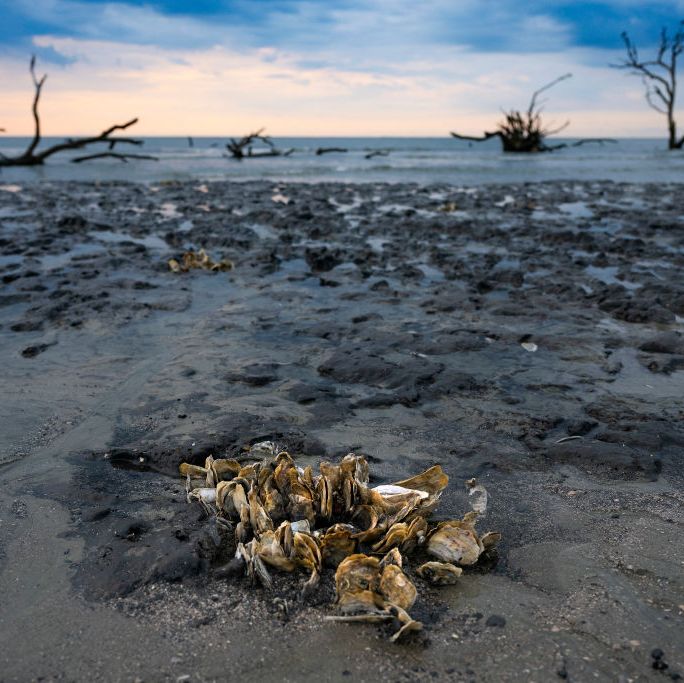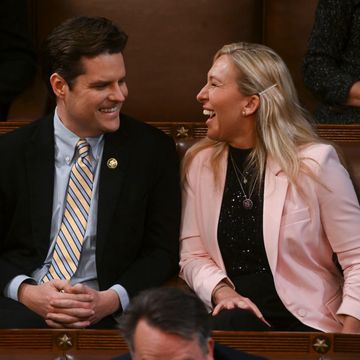For seven seasons I have worked as a commercial oysterman along the waters of the South Carolina Lowcountry. Current mapping shows that there are 4,664 acres of wild oyster beds that grow between the limits of high and low tide here. I am responsible for 4.8 of them.
I lease my oyster beds from the state, which gives me exclusive use of “intertidal portions of Inlet Creek, Swinton Creek, unnamed creeks, and tributaries near the Intracoastal Waterway . . . for the purposes of commercial shellfish culture.” In exchange, I pay a nominal fee every year and commit to restoring more than I take. South Carolina’s wild-oyster season opens when the waters cool and closes when the waters warm—a window that seems to be getting smaller every year. The season usually starts in September, but I wait until November to begin harvesting, when water temperatures have dropped below 70 degrees and the spawning oyster’s bitter taste of cream has become sweet again in preparation for winter.
The work, as I do it, is solitary. Conditions are wet and muddy, and it is often cold and windy or hot and not windy enough to discourage the no-see-ums that bite at my neck. I can only work at low tide, and really only the lowest of tides, which drop enough to expose the entirety of my beds. My schedule, then, is inconsistent, changing daily according to the tides and the phases of the moon. My equipment includes a pair of rubber boots, a pair of socks made only of wool, a boat that is small enough to navigate a narrow channel but big enough to compete with the flow of an ebbing tide, a ten-ounce hammer, a pair of gloves that will not cut easily on the razorlike beaks of an oyster in springtime, and however many milk crates I think I can fill with a day’s harvest.
I have managed the same oyster beds now for six of my seven seasons. Every season, I understand more of the nuances of the place I husband—how the waters flow, where the sediment moves after a storm, where the oysters grow fast and thin and where they grow slow and thick, and even the patterns of the migratory birds that pass through these parts.
A wild oyster will grow in different ways depending on the slope and sediment type of the bank on which it lives, the substrate onto which it originally attaches, the amount of energy that flows through that area, the food availability, the salinity and temperature of the water, and the pressures of predators. The sum of these variables determines the shape and coloring of its shell and how it tastes. An oyster harvested from the waters of Charleston will look and taste different than one harvested from Cape Cod Bay. And yet, on the East Coast and throughout the Gulf, they are all the same species, Crassostrea virginica. There is no debate in my mind on the role of nurture versus nature in the world of the oyster. Nurture wins.
The fall before I started oystering, rains, which were described technically as a “fire hose” associated with Hurricane Joaquin, fell so hard (15.5 inches over five days at the rain gauge near my oyster beds) that the state prohibited harvesting in my area for nearly two months. South Carolina’s policy is to close shellfish areas whenever four or more inches of rain falls in a twenty-four-hour period, after which the health department tests the water quality to ensure safety before opening the beds again. Heavy rains can infiltrate and overwhelm degraded wastewater infrastructure, sending raw sewage into nearby waters. Further, stormwater runoff that discharges directly into our creeks and rivers and harbors carries just about anything we put on the land: pesticides, fertilizers, oil, antifreeze, dog poop. In 2016, rains from Hurricane Matthew caused the closure of my oyster beds for twenty-eight days after two sewer overflows forced seven thousand gallons of sewage into nearby waters. In 2017, Hurricane Irma delayed the opening of the wild-oyster season by two weeks because of water-quality impacts. In 2018, 2.4 million gallons of sewage spilled into the Stono River from a broken sewer line, shutting down shellfish beds in that area for a precautionary twenty-one days. And just last year, Hurricane Ian forced a preemptive statewide closure just as the season was opening. As storm events become more frequent, as coastal communities become more developed (Charleston County saw a 23 percent increase in impervious land area between 1996 and 2016), and as our nation’s infrastructure continues to degrade underground, the waters where we swim and fish and where we harvest oysters will increasingly come under threat, as will the livelihoods that rely on clean water.
Five of the ten highest tides in Charleston’s recorded history have happened since my first season as an oysterman. Salt marshes, especially ones in low-lying areas like the Lowcountry, are critical in protecting upland environments from rising seas and storm surge. Unfortunately, South Carolina has lost 27 percent of its wetlands since the 1780s from filling and land conversion, and its salt marshes continue to erode at an average rate of 1.1 feet per year. The greatest defense against the filling of wetlands today is often legal action—as I’m learning firsthand through my part as a cofounder of Friends of Gadsden Creek, which is challenging a state permit that would allow Gadsden Creek and its wetlands in downtown Charleston to be filled in and destroyed—while erosion is best mitigated with mechanical structures. Wild oyster beds are one of the greatest forms of shoreline protection that exists. Their reef-like structure dampens energy from waves and boat wakes and prevents the erosion of the shorelines they inhabit. What’s more, their ability to migrate upward over time as waters rise creates dynamic defenses. Overharvesting wild oyster beds can leave a bank barren and vulnerable.
Every summer, after the season closes and the oysters begin to spawn, I work to restore sections of salt marsh within our lease whose banks were stripped of oysters long ago. I plant wooden stakes along the intertidal zone to which microscopic oysters will attach in the summer and eventually grow into dense, mature clusters. With time and additional generations of oysters, these growing clusters become healthy beds, and the eroded marsh will begin to heal itself.
On the day I got my commercial fishing license in December 2015, there was another fisherman in the office filling out paperwork. He asked me what I’d be fishing for.
“Oysters,” I told him.
“There’s no money in oysters,” he said.
Now with seven seasons behind me, I can see that he may have been right. Yes, I’ve managed to fish for seven seasons, but every year I’ve needed to supplement my income with other work, and every year I wonder whether it will be my last. But any work that slows us down and brings us close to the natural rhythms of the world is important work because of what it does to the deepest part of us. To care for wild oysters is to participate in a web of interdependencies. To care for wild oysters is to steward the salt marshes that protect our homes and that serve as nurseries for juvenile fish. To care for wild oysters is to surrender to the tides and the winds and the rains to feed our neighbors, and to steward the culture of a place where the backyard oyster roast signals the start of fall more than any date on the calendar. To care for wild oysters, 4.8 acres at a time, season after season, is to care not only for oneself but in no small way for the planet we will leave behind.
Keep Reading:
- What If Things Get Better?
- When the End of Human Civilization is Your Day Job
- It's Too Late to Prevent Climate Migration in the U.S.














